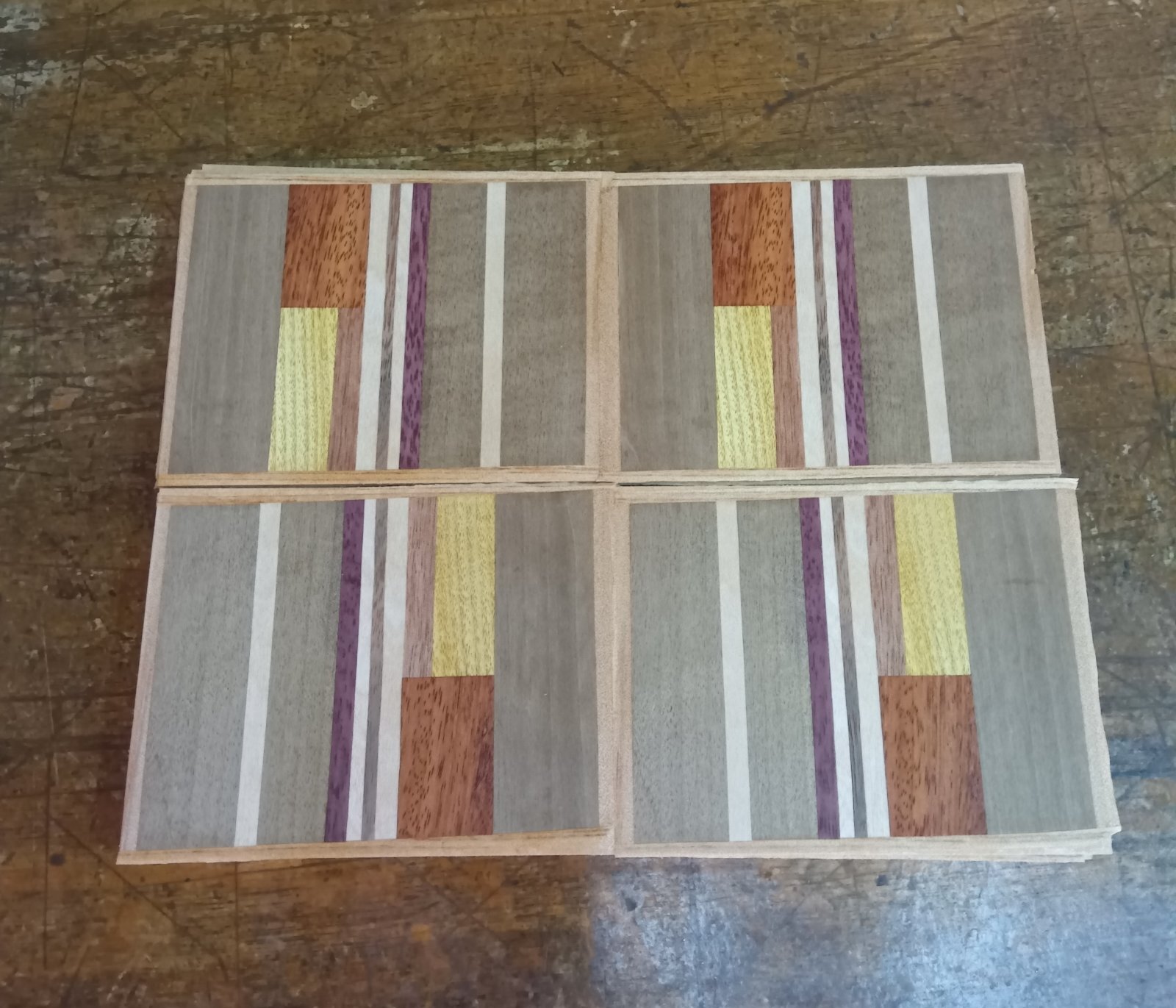Creative yosegi
From today, the temperature in our area has finally started to drop a little. It’s only by about 3–5 degrees, but at least it no longer feels so unbearably hot that you can’t even go outside. For example, today it’s 32°C, which feels very different compared to 36–37°C. With the air conditioner on indoors, it’s much more comfortable (haha).
At the moment, I’m working on Mame puzzle boxes and 5-sun boxes. After these, I plan to start on an overseas shop order. At the same time, I’ve been thinking about what to make for a September limited edition. I still have a little yosegi sheet left from the creative yosegi I made in July, so I’m considering using that. These sheet for a 4-sun size, and last time I made 4-sun 18-steps boxes. However, this sheet is slightly larger than 4-sun, so I can also make a 4.2-sun size this time. There is enough yosegi left for about 16 boxes (if applied to the top and bottom), so that will probably be the September limited edition.
Sixteen is a little small for a single batch, so I may add another design as well, aiming for around 20–30 boxes in total. After that, this particular creative yosegi will be finished, and I will move on to something else in the future. I never make exactly the same design again.
This type of yosegi, with slightly larger blocks of wood combined together, is difficult to slice. The sheets often tear or develop holes during slicing. On the other hand, traditional yosegi patterns with very fine details are actually easier to slice (of course, it’s not easy, but from that point of view!) This is because wood has many fibrous lines—these create the wood grain. The fibers are very strong, and when sliced, they tend to bend or follow the direction of the grain. The larger each block of wood is, the stronger this force becomes, causing the sheet to tear or warp.
By contrast, traditional yosegi with many fine, mixed pieces of wood balances out these forces. Each piece cancels out the strength of the others, resulting in a sheet that slices more smoothly. However, fine yosegi has its own challenges—because the pattern is so detailed, there are many glue joints, and if the bonding isn’t strong enough, the tiny pieces can come apart. In that case, the risk of peeling is actually higher than with simpler patterns.
In the end, both types have their own difficulties, each in a different way.
For the limited edition 4-sun or 4.2-sun box, since the number I can make will be quite small, I’m thinking of making it a larger step type—maybe 21 or 27 steps. By the way, the 4-sun 18-steps box (type 202507) from July now has only 2 pieces left, thank you 😊
At the moment, I’m working on Mame puzzle boxes and 5-sun boxes. After these, I plan to start on an overseas shop order. At the same time, I’ve been thinking about what to make for a September limited edition. I still have a little yosegi sheet left from the creative yosegi I made in July, so I’m considering using that. These sheet for a 4-sun size, and last time I made 4-sun 18-steps boxes. However, this sheet is slightly larger than 4-sun, so I can also make a 4.2-sun size this time. There is enough yosegi left for about 16 boxes (if applied to the top and bottom), so that will probably be the September limited edition.
Sixteen is a little small for a single batch, so I may add another design as well, aiming for around 20–30 boxes in total. After that, this particular creative yosegi will be finished, and I will move on to something else in the future. I never make exactly the same design again.
This type of yosegi, with slightly larger blocks of wood combined together, is difficult to slice. The sheets often tear or develop holes during slicing. On the other hand, traditional yosegi patterns with very fine details are actually easier to slice (of course, it’s not easy, but from that point of view!) This is because wood has many fibrous lines—these create the wood grain. The fibers are very strong, and when sliced, they tend to bend or follow the direction of the grain. The larger each block of wood is, the stronger this force becomes, causing the sheet to tear or warp.
By contrast, traditional yosegi with many fine, mixed pieces of wood balances out these forces. Each piece cancels out the strength of the others, resulting in a sheet that slices more smoothly. However, fine yosegi has its own challenges—because the pattern is so detailed, there are many glue joints, and if the bonding isn’t strong enough, the tiny pieces can come apart. In that case, the risk of peeling is actually higher than with simpler patterns.
In the end, both types have their own difficulties, each in a different way.
For the limited edition 4-sun or 4.2-sun box, since the number I can make will be quite small, I’m thinking of making it a larger step type—maybe 21 or 27 steps. By the way, the 4-sun 18-steps box (type 202507) from July now has only 2 pieces left, thank you 😊
